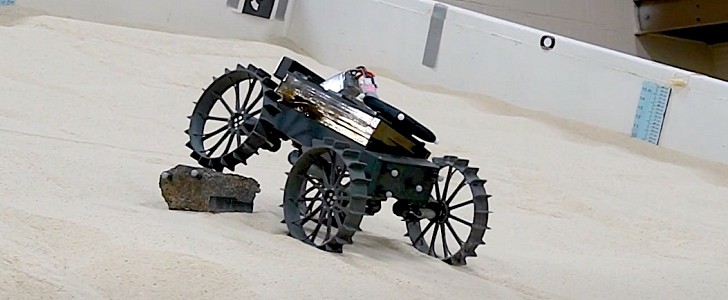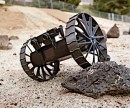The most glamorous part of the Artemis moon exploration program is of course the one that involves the mighty Space Launch System rocket, the Orion spaceship, and the people who will be riding both of them to the Moon and back. But the reality is Artemis is far, far more complex than that.
One of these many other aspects of the program has to do with the army of machines that will scout, survey, sample and perhaps even exploit the lunar surface. Virtually none of them is ready for duty, but NASA is working hard on testing their forefathers in laboratories across the country.
SLOPE, or Simulated Lunar Operations lab, is the place where NASA tests rovers and more specifically, the wheels that go on them, in conditions that emulate those found on Mars and on the Moon.
The latest tests included the rovers from the CADRE family. That’s short for Cooperative Autonomous Distributed Robotic Explorers, in essence, networked robots the size of shoe boxes that should be able to autonomously and in teams, survey our planet’s satellite and map portions of it in 3D.
Due to their size, NASA was concerned about their ability to move through the tricky regolith, so SLOPE was called to lend a helping hand.
According to Alex Schepelmann, lead roboticist for SLOPE, wheel traction in various conditions was tested, including while navigating over large lunar rocks and inclined slopes.
The idea was to see just how much wheel slip the rovers get, as that could have a significant impact on the accurate mapping abilities of the machines. Sadly, NASA does not say what values it found.
CADRE robots will use “an inertial measurement unit, stereo cameras, and a Sun sensor to track the position of each scout as they explore the lunar surface.” The first one of the family should go to the Moon on a commercial robotic lander sometime over the next five years.
SLOPE, or Simulated Lunar Operations lab, is the place where NASA tests rovers and more specifically, the wheels that go on them, in conditions that emulate those found on Mars and on the Moon.
The latest tests included the rovers from the CADRE family. That’s short for Cooperative Autonomous Distributed Robotic Explorers, in essence, networked robots the size of shoe boxes that should be able to autonomously and in teams, survey our planet’s satellite and map portions of it in 3D.
Due to their size, NASA was concerned about their ability to move through the tricky regolith, so SLOPE was called to lend a helping hand.
According to Alex Schepelmann, lead roboticist for SLOPE, wheel traction in various conditions was tested, including while navigating over large lunar rocks and inclined slopes.
The idea was to see just how much wheel slip the rovers get, as that could have a significant impact on the accurate mapping abilities of the machines. Sadly, NASA does not say what values it found.
CADRE robots will use “an inertial measurement unit, stereo cameras, and a Sun sensor to track the position of each scout as they explore the lunar surface.” The first one of the family should go to the Moon on a commercial robotic lander sometime over the next five years.








